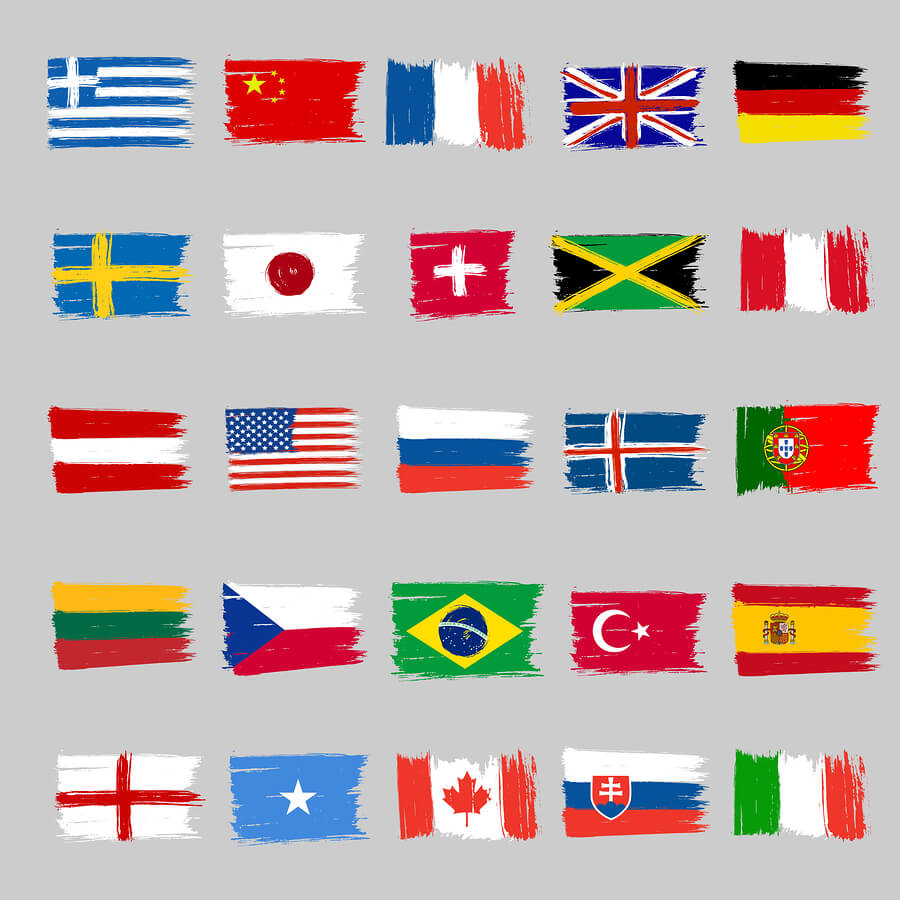Linguists and scientists have conducted many studies showing how language shapes how people both behave and think. Language is a part of a culture and so it has an important effect on how a person thinks, which affects how they behave.
The way speakers provide an interpretation of the everyday things that they feel, see and hear around them can be complex because of the influence of personal experiences through traditions, norms, cultural rules and languages. Thoughts originate from words and the thoughts themselves initiate behaviour.
Global business and international communication are affected by languages as well so there is a pressing need to get localized and get language translations. To do business in another country, a business has to be able to deliver product messages to both their employees and their targeted audiences in an appropriate language that can be clearly understood. Localization basically means that all types of communications have to be translated into the targeted local language. The training of local employees in the corporate culture must match the local culture otherwise it’s doomed to fail.
People use their language every day in order to communicate, celebrate, negotiate, argue, learn, document and legislate. People each day are exposed to language from the media, indoor and outdoor and websites. In societies which are still not so technologically advanced, knowledge is more likely to be transmitted orally.
Connection between culture and language
Every language perceives the world in a slightly different way which means the speakers of a specific world language view things somewhat differently. It takes a lot of learning and understanding by researchers before they can fully understand the relationship between culture and language in a society they are studying. This ultimately affects language translations.
Category: General
What is Book Meta Data Translation?
Every author wants a book to find its way to an international audience. The use of metadata is becoming increasingly important as a method of getting discovered by a larger audience.
If you have written a book which has a single niche say for example a sci fi novel about a colony in outer space and you enter it as metadata, you would expect it to assist your book to rank uniformly, internationally. However, you find your sales won’t pick up despite of following all the tips of translation. This is because your book can’t be easily found by search engines like Baidu in China. This is due to the fact that it promotes metadata translation in Chinese languages and not English metadata. There are most likely potential readers that would love your book but it’s simply not discoverable by them.
This problem can be solved when the book is well translated and well placed. Metadata can assist your books to get new readers and increase your sales, whatever the language.
An Overview of Book Metadata
Book metadata assists search engines to connect your book to readers by providing a way for the search engines to index online info. Metadata translation assists users to find the product or content they are looking for. For the book publisher, this is particularly important, as metadata will attract potential readers to your books’ titles. When somebody keys into a search engine a query, the search tool quickly reviews numerous web pages to source the metadata that fits best the query. The amount of detail, its accuracy, and its relevance of the book’s metadata can have an impact directly on its visibility. Metadata translation for a book typically includes the following:
- Name of author and any contributors;
- International Standard Book Number (ISBN), with book title, and its subtitle;
- Book description plus a synopsis and cover image;
- Publication date and the name of the publisher;
- Genre and subject matter;
- The book’s price;
- The targeted audience;
- A table of contents;
- Reviews, excerpts and quotes from the book.
Precise Translations and Better Metadata
As metadata seems to be an important part of publishing a book, accurately translated metadata is significant too. When somebody is looking for a book, inaccurate and poor translations will mean the book will be hard to find.
The main benefits of a book metadata translation are:
1. A Notable Sales Increase
When 3 descriptive data components are there, there is a 72% rise in books sales when compared to books without descriptive data. Also book titles with keywords experience average sales 34% percent greater than book titles that don’t have keywords.
2. Improved Discovery of the Book
This will mean that those after your book to put it into their country’s supply chain can appropriately plan their orders. It will also enable readers searching for books of interest to them to find your titles prior to publication, and perhaps even order them in advance.
What’s New in Facial Recognition Technology?
Not that long ago a team of behavioural scientists and linguists were helicoptered in to a remote valley in Irian Jaya, the Indonesian half of the huge island of New Guinea. They had heard that there were people living in the valley that had never before been encountered. No-one knew what language they spoke so there was no-one who could translate what they said into English. One of the purposes of the expedition was to investigate the theory that human facial signals were universal, in other words they were not culturally ‘learned.’
The results seemed to confirm the theory. Without the use of translators it was discovered that basic human facial signals were just the same as those used naturally by the researchers: smiles indicating friendliness and humour; frowns for confusion and anger; quizzical looks when unsure of the meaning of an action and so on.
This was universal ‘facial recognition translation’ between two groups of human beings that knew nothing about each other.
Facial recognition technology has since become much more refined and has become part of the technology used by immigration authorities and law enforcement because of its effectiveness. Few people who have experienced arriving at an international airport today would not have been subject to biometric scrutiny, which matches a face on a passport to a database. The facial recognition software used at such gateways is so sophisticated that entry is now often completely automatic. As long as your own face matches the biometric features on your passport you are allowed to pass through the barrier. At the same time your entry is recorded by immigration authorities and matched against a criminal database in case you are trying to evade police by slipping into or out of a country.
Facial recognition technology is now used in a myriad of new ways. You can use it to search for references to yourself anywhere on the internet. It’s not confined to that either. In what has become a more controversial use you can also search for people you know on the internet just with the use of a single photograph of the person’s face. Facial recognition may soon replace keys and security keypads because it is at least at present impossible to forge.
Facial recognition is one step up from fingerprint recognition, mainly because faces are recorded in far more numerous ways than fingerprints are. A thief is caught on a CCTV camera and providing that his (or her) face is not obscured by a mask or balaclava the image can be compared to a list of suspects held by the police, or even compared to an internet search in case there are clues to the identity of the criminal.
Planning a Trip to the 2018 FIFA World Cup in Russia?
Its four years since the last exciting Soccer FIFA World Cup that was held in the soccer-mad country of Brazil. This time it is in the almost equally soccer mad country of Russia. If you are thinking of attending any of the matches or all of them then there may be many things to think about before setting off for Moscow later this year.
Tickets for FIFA
Ticket sales for the FIFA World Cup are officially closed, but you may still be able to purchase a ticket for an individual game. Check the website.
Visas for Russia
Russia has waived the usual requirement to get a valid tourist visa before coming to the country to enjoy the FIFA World Cup. Instead, the only requirement is to make sure you get what the organisers call a “Fan I.D.” The fan I.D. is available to anyone who has purchased a ticket to any or all of the World Cup matches. The Fan I.D. is not just to show to officials or any of the match organisers, but you can also use it to get special discounts while you are in Russia like hotels and restaurants. Make sure to get your Visas Translated in advance!
How to get Russia for FIFA
The easiest and fastest way to get to Moscow and many of the matches scattered around the country is by air. Remember Russia is a very large country and matches are taking place in 11 different cities and 12 different stadiums.
When you are in Russia you have the option of flying to other cities, taking a train or a bus. The country is well served by all three forms of transport, but be prepared to take a long time if travelling over land. It takes over 11 hours, for example just to travel from Moscow to St. Petersburg by train!
Getting Accommodation in Russia for FIFA
It is best to book accommodation in advance rather than leave it to when you get to a city to watch a match. There are now plenty of accommodation options right across the country and you should not have any difficulty finding a room. Give your fan I.D. number when booking and you may get a special discount for Soccer FIFA World Cup fans!
Communicating in Russia
There are approximately 144 million people in Russia and most of them speak Russian, even if it is not their native language. Russian is not that easy to learn as it is not related to English and most signs are in completely different alphabet, Cyrillic. However, learning a few words or phrases in Russian will break the ice when talking to locals and there are several words that you will certainly recognise like “vodka” and “futbol!”
Lost in Translation: Kids as Translators Have So Much to Lose
If you aren’t fluent in a language, relying on your kids’ English speaking interpreters too much puts far too much responsibility and weight on them.
If you happen to visit a clinic, a bank, or a grocery store in California, it’s quite common to see kids translate for their parents who don’t speak English. Even though in a hospital setting for instance, a patient is entitled to the services of an interpreter a child often steps in. The child may even be in the position of taking responsibility for transmitting life and death information to his or her parents. This is not entirely fair on the child or the parent just because the spoken English by kids is the only possible remedy for parents who have limited knowledge of English.
Children are often given the responsibility of translating immigration, financial and medical documents. This exposes them to all sorts of aspects of life that they have no real understanding of. This can affect the child’s social interactions at school and with persons in authority. There is also a sense of role reversal when a child ends up playing the adult role on behalf of his/her parents. Because a child doesn’t have the same understanding of life as an adult his or her knowledge could be lost in translation when explanations are given on situations that require an accumulation of knowledge.
There are solutions available and that’s providing interpreting and translation services administered by government agencies. Others would say the parents should make more effort to learn English, but this isn’t always an option for people who have only recently arrived in a country where their native language is not spoken. Immigrants’ children tend to learn English quite quickly, which allows faster assimilation into the culture and they become burdened playing the role of interpreter and translator.
Perhaps the service providers involved in government agencies, health care and financial services should make more effort to reach out to immigrant populations. This in the first place means making available materials in appropriate languages, providing interpreters who are just a phone call away and releasing children of the burden of providing interpretative skills on what are often seen as sensitive matters that children have little knowledge about but are given the burden of trying to translate sensitive information about topics which they possess little knowledge due to their worldly knowledge and experience.
The 3 Official Languages of the 2018 Olympics Games
The 2018 Olympic Games in South Korea are just over, after having taken place in Pyeongchang County, South Korea. The 2018 Winter Olympics were officially referred to as the XXIII Olympic Winter Games and came to be known as Pyeongchang 2018. It was an important multi-sports event held from 9th to 25th February 2018 in Pyeongchang. The number of athletes who participated was 2,922.
Preparing a country to take on an international event like the Olympic Games is not only a privilege but a challenge too. The Olympic Games involve a mass of people, both contestants, and spectators from all over the world and they can’t all speak English. The organizers have to somehow jump over the hurdles faced by the language barriers that exist at such an international event.
The Official Languages of the 2018 Winter Games
Wherever the Olympic Games are taking place, the committees have 3 official languages of the Olympics. These are the English official language and the French official language, while the 3rd is the language of the country where the Olympic Games are taking place. For 2018’s games, Korean is the third language, which is the official language of Korea.
Korean is the language spoken in both North and South Korea and by around 80 million people globally. At the Olympics, interpreters will be present amongst the Olympic staff to ensure the Olympics information is made available to all those who attend the games.
Whenever the main language, Korean, needs to be written, those attending will be able to view the Hangul Script. This is an ancient script and a highlight of the 2018 Winter Games.
Branding the Winter Olympics
The Hangul scripts can be seen in the emblem of the games, which shows a unique presentation of 2 Hangul letters which are:ㅍ (p) and ㅊ (ch). These letters from the base sounds of “Pyeongchang.” The emblem also brings together images of snow and ice with the winter sports stars and people from throughout the world who are coming to Pyeongchang where heaven meets the earth.
Social Media and the Olympic Winter Games
Social media is vital for all Olympic teams and with the variation in the athletes as a diverse group many of the team’s fans only have social media as a means of connecting with one another. Translation, therefore, becomes vital to enable good engagement on social media throughout the period of the games. To help promote engagement, the Olympic Channel broadcasts any news in relation to the Olympic Games through social media accounts in several languages including Spanish, English, Korean and Portuguese.
5 Arabic Poets You Should Recognise For International Women’s Day
English Translation
There is no better way to celebrate International Women’s Day than appraise the work and lives of poets who don’t write in English but have had their poems translated into English. This article is about 5 female poets who write in Arabic but their short poems have appeared in Banipal and Words Without Borders with an English Translation.
Rasha Omran
When Longing Tormented Me
This poem’s English Translation was provided by Camilo Gomez-Rivas and was subsequently published in Banipal in Spring 200. Rasha Omran was born in 1964 and has become known as a acclaimed Syrian poet. She is a political activist and has spoken on behalf of civilians in Syria and is also against the Syrian regime. In 2012 she fled Damascus, her home city, for Cairo. She has a particular view of poetry by saying it’s not always about happiness but reveals the darkest corners of the subconscious which often dwells on losses and not gains in the poet’s world.
Rana Al-Tonsi
A Rose for the Last Days
A Rose for the Last Days was translated by Sinan Antoon, and was subsequently published in Banipal in Spring 2006. Rana al-Tonsi was born in 1981 in Cairo and now lives in Doha, Qatar. Between 2005 and 2015 she has published 8 poetry books and is a well known poet in the Arab world. The style of her poetry is described as both rebellious and intimate.
Nujoom Al-Ghanem
A Night Heavy on the Night – Two Poems
Khaled al-Masri translated these poems in 2011 in Banipal. Nujoom al-Ghanem was born in 1962 and classifies herself as a full-time poet. She is based in Dubai, United Arab Emirates and between 1989 and 2008 has published 6 poetry collections. It took a while to become recognised as women were not permitted to publish their names alongside poetry they had written if it was to be published in the media.
Reem Ghanayem
Mag, fi Sirat al-Manafi – Selected poems
Reem Ghanayem created the English Translation of her own poems which were published in 2012 in Banipal. She was born in 1982 and lives in Western Baqa which lies in Palestine within the Green Line. She has managed to publish 2 poetry collections.
Soukaina Babiballah
Anatomy of the Rose
The English Translation of Anatomy of the Rose was done by Kareem James Abu-Zaid, and subsequently published in 2016 in Words Without Borders. Soukaina Babiballah was born in 1989 and she is from Casablanca in Morocco. She has up to this date published 2 poetry collections and she has also been awarded an Arab Fund for Arts and Culture (AFAC). This enabled her creating her 1st novel grant for the organization’s novel-writing Bait Alqashlah which was published in 2016 by the Arabic Scientific Publishing in 2016.
So on March 8th on International Women’s Day there are 5 female poets of Arabic origin who represent the struggle of women in the Arabic world to create equality for all.
10 Commonly Used Aussie Slang Words and Expressions
Every language has its slang and the English used by Australians is no exception. Because of a number of Australian soap operas, short films and actors, Aussie slang has reached the ears of the world. Yet the words and expressions that Australians use today is not the same as it was a hundred or even thirty years ago. Like all other languages, expressions go out of fashion and new ones emerge.
Aussie slang has been influenced by an all-pervading American culture, so some expressions commonly heard in Australia these days may very well be more American than Australian. Other expressions are from the English of England, especially the rarely heard these days rhyming slang which was common at one time in Cockney London.
So what are some common Aussie slang words and expressions? Here are 10 of them.
#1 Ending a word with ‘ie’ or ‘y’, such as ‘Brizzie’ for Brisbane, ‘barbi’ for barbecue, ‘tinny’ for a dinghy, and ‘Aussie’ (of course!) for Australian. Don’t try improvising this yourself or you may get a few strange looks!
#2 G’day is the very common Aussie greeting and another example of an abbreviation of the ‘Good Day’ used elsewhere in the English-speaking world.
#3 A bloke is a man, just as it is in England and New Zealand, although these days, the American ‘guy’ may be heard just as much, especially by younger Australians. Guy, of course, is nongender specific, while ‘bloke’ definitely refers to a man! The old term for a female, ‘sheila’ has almost completely died out except amongst older Australians.
#4 A dunny is the term for a toilet, although many people may use the more English ‘loo’. Americans find this a bit tricky, as a ‘dunny’ in Australia is a ‘long drop’ in the U.S.!
#5 A cobber is a friend, also a bit old-fashioned these days and usually replaced by the word ‘mate’, which although usually used for males in the past tends to be more gender non-specific these days and is equivalent to the American ‘pal’.
#6 A snag is a sausage, not a fallen down tree, as it in U.S. English! Snags are usually destined for the barbie!
#7 A stubby is a short bottle of beer, around 330 ml or 375 ml, and is not the correct term for a can of beer of the same volume. Stubbies are usually placed in a ‘cooler,’ which is a beer cooler that snugly fits the bottle (or can).
#8 The term ‘No worries, mate’ is authentically Australian, usually uttered after some calamity such as a car crash, losing one’s job or after one’s spouse has run off with the neighbor.
#9 An arvo is an afternoon and maybe a useful time for a bit of downtime, maybe for a cold stubby!
#10 There are many old Aussie slang terms that you may still hear from time to time like ‘drongo’ and ‘galah’ for people who are either scatty-minded or stupid; ‘Bonza’ is rarely heard these days and means ‘great’.
What Languages Are Spoken In Australia?
The Australian national language is English and it is this language that is spoken freely as a first language by the majority of the country’s inhabitants and is the official language of government and education. There is no need to translate English to Australian as there is no significant difference between the English of Australia and that of England. English started to take over from aboriginal languages after the country was systematically colonized by the British in the the1780s. Today, English still dominates but there are some aboriginal languages that still exist, albeit only in small isolated pockets in more remote parts of the country.
How Many Different Languages are Spoken in Australia?
There are several other languages spoken in Australia apart from English. The way that government authorities determine what main languages are spoken in Australia is from census information provided by those living in the country at the time of the census, which takes place every 5 years. Over the last 15 years, there has been some change in what are the languages spoken in Australia and the most spoken languages in Australia. In 2001, 80 percent of the population indicated that the main language they spoke at home was Australian English. By 2006, which was the next census, this had dropped to 79 percent, while by 2011 the English-speaking number had decreased further to 76.8 percent.
By 2016, the census showed that 72.7 percent of Australia’s population spoke English as their main or native language. This trend is due to immigration changes in the country. Previously most immigrants came from New Zealand and the United Kingdom but this trend is starting to change. Out of the 6,163,667 people in the country who were born overseas, almost one in five, or 18 percent, had entered the country since the beginning of 2012. The 2016 Census revealed that 67 percent of Australians were born in the country. Almost half, 49 percent, had been either born abroad, or 1 or both of their parents had been born abroad.
The immigration trend has now changed to the extent that English is slowly losing its importance and other languages are replacing it. This doesn’t mean that immigrants don’t speak English, as they have to pass English tests before they are allowed to migrate into Australia. In the early stages of the life of an immigrant, their native language would accompany them and would continue to be used in the family environment until children have passed through the Australian education system, where the only language used is English. Unless a language is actively maintained by the family and the country they live in the native language will start to lose its importance, but that can take several decades.
The other languages spoken in the country depend on which countries in Australia people come from. The top countries are Arabic-speaking countries, China, Italy, Vietnam, and Greece. Second to English is Mandarin with 2.5 percent of Australia’s population speaking the language, followed by Arabic with 1.4 percent speakers; thirdly Cantonese with 1.2 percent of speakers and Italian and Vietnamese attracting 1.2 percent. Greek is also spoken too, but Greeks were early migrants to Australia and the language does not have so much importance today. Added to this percentage is the 1 percent of the population that speak indigenous languages, of which there are at least 50 languages spoken in Australia today.
Top Languages Spoken in Australia
The Other Top Languages Spoken in Australia Include:
● Nepali
● Malay
● German
● Spanish
● Hindi
● Filipino
● Spanish
● Korean
● Punjabi
● Afrikaans
● Malayalam
● Fiji
● Dutch
● Min Nan
● Sinhalese
● Tagalog
● German
● Indonesian
● Afrikaans
● Japanese
● Polish
● French
● Thai
● Urdu
What Does Diversity of Language Mean to Australia?
In 2016, more than 300 languages were identified as being spoken in Australian homes. More than 21 percent of Australians spoke at home a language that’s not English Tasmania had the greatest number of people who only spoke English in the home, with 88 percent, and Northern Territory had 58 percent, which was the lowest. Language is something you can’t remove from people as it allows for effective communication of the beliefs and values of a particular culture.
This diversity of language is an asset to Australia as it helps to foster international ties and trigger cultural exchanges. It’s useful to have people living in a country who naturally speak another language apart from the national language of the host country. They can act in bilingual situations when their skills may be needed to facilitate trade agreements or to engage in communication between countries that have diplomatic ties with Australia. They can act as interpreters or translators in court cases or in medical situations where those involved don’t have full command of Australian English.
Australian Aboriginal languages
In the later part of the 18th century, there were 250 Aboriginal social groups and they shared around the same number of aboriginal languages. By the 21st century, there were fewer than 150 Aboriginal languages still used on a daily basis. Most are today likely to disappear completely, except 13, which are still taught to children and are only found in the most isolated areas. Out of the 5 which are least endangered, four belong to the Ngaanyatjarra grouping in Western Australia who are found in the Central and Great Victoria Desert. North East Arnhem land in the Northern Territory still teaches Yolŋu languages to children as part of bilingual education programs. Tiwi, Warlpiri, and Murrinh-path, also in the Northern Territory, have from 1,000 to 3,000 speakers.
For the time being English is still the dominant language in Australia and embedded in it is Australian English, which even though is clearly recognizable as English today, has absorbed words, phrases, and idioms from North America. In fact, there are many ways that Australia resembles America, particularly in the design of its towns and cities which both follow post-colonial lines and lack historical buildings and quaint villages and towns you find in England. Some Australians are quick to mimic American English they hear on mass media and words like ‘truck’ and ‘guys’ are embedded in Australian English. Australian English also has a whole vocabulary that has developed in isolation and is recognizably ‘Australian.’ While it would be pushing it too far to say that Australians speak Australian, they certainly can be recognized by their accent, which is recognizably distinctive.
Translating In the Field Of Sport
The translation of documents has increased in leaps and bounds over the decades so that means there are more and more openings for good translators.
Translation plays a key role in sport because sports players and athletes follow the sports events around the world. There is always a need for communication and sport is no exception. Some teams recruit new team members to come to their country to play but they still need to follow immigration rules which could mean translating supporting documents into English. Rules and regulations of a sport need to be made freely available to all team players, whatever their native language, when they come to play in a country that doesn’t speak their language.
Recently, following a baseball game in the United States, some specific events finally persuaded their industry of the real need for qualified translators. The main reason for this was the players weren’t fully fluent in English and needed a helping hand to stay involved in the sport. There was a recent case of a Dominican player who had to be expelled because of his use of pine tar, which the league disallowed. He was unable to respond when bombarded with questions by the media in relation to the incident because of his language deficiency. The various authorities in charge of the league are trying to seek a solution to the limited number of translators who are currently available to ensure every team member has sufficient language back up.
There are too many examples in soccer to count, but in baseball, more than 200 Latin American players are in the baseball league. They of course can’t all speak English so they will need help when visiting an English speaking country.
The fact of the matter is that the translation industry has spread its wings so it is able to handle all the new arenas that are emerging in the sporting world. More and more overseas visitors attend major sporting events around the world often in countries where their language is not spoken. There is a need for clear translations at these sporting events of important information that visitors need to know.












